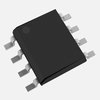Part Details for SSM2212RZ-RL by Analog Devices Inc
Results Overview of SSM2212RZ-RL by Analog Devices Inc
- Distributor Offerings: (3 listings)
- Number of FFF Equivalents: (0 replacements)
- CAD Models: (Request Part)
- Number of Functional Equivalents: (0 options)
- Part Data Attributes: (Available)
- Reference Designs: (Not Available)
Tip: Data for a part may vary between manufacturers. You can filter for manufacturers on the top of the page next to the part image and part number.
SSM2212RZ-RL Information
SSM2212RZ-RL by Analog Devices Inc is a Small Signal Bipolar Transistor.
Small Signal Bipolar Transistors are under the broader part category of Transistors.
A transistor is a small semiconductor device used to amplify, control, or create electrical signals. When selecting a transistor, factors such as voltage, current rating, gain, and power dissipation must be considered, with common types. Read more about Transistors on our Transistors part category page.
Price & Stock for SSM2212RZ-RL
| Part # | Distributor | Description | Stock | Price | Buy | |
|---|---|---|---|---|---|---|
|
DISTI #
505-SSM2212RZ-RLCT-ND
|
DigiKey | TRANS 2NPN 40V 20MA 8-SOIC Min Qty: 1 Lead time: 10 Weeks Container: Cut Tape (CT), Tape & Reel (TR) |
812 In Stock |
|
$4.6250 / $10.0400 | Buy Now |
|
DISTI #
584-SSM2212RZ-R
|
Mouser Electronics | Bipolar Transistors - BJT Low Noise,Matched Dual NPN Transistor RoHS: Compliant | 0 |
|
$4.6200 | Order Now |
|
|
Analog Devices Inc | Low Noise,Matched Dual NPN Tra Min Qty: 1 Package Multiple: 2500 | 163 |
|
$3.5200 / $10.0400 | Buy Now |
Part Details for SSM2212RZ-RL
SSM2212RZ-RL CAD Models
SSM2212RZ-RL Part Data Attributes
|
|
SSM2212RZ-RL
Analog Devices Inc
Buy Now
Datasheet
|
Compare Parts:
SSM2212RZ-RL
Analog Devices Inc
Audio Dual Matched NPN Transistor
|
| Pbfree Code | No | |
| Rohs Code | Yes | |
| Part Life Cycle Code | Active | |
| Ihs Manufacturer | ANALOG DEVICES INC | |
| Part Package Code | SOIC | |
| Package Description | SOIC-8 | |
| Pin Count | 8 | |
| Manufacturer Package Code | R-8 | |
| Reach Compliance Code | compliant | |
| ECCN Code | EAR99 | |
| HTS Code | 8541.21.00.95 | |
| Samacsys Manufacturer | Analog Devices | |
| Collector Current-Max (IC) | 0.02 A | |
| Collector-Emitter Voltage-Max | 40 V | |
| Configuration | SEPARATE, 2 ELEMENTS WITH BUILT-IN DIODE | |
| DC Current Gain-Min (hFE) | 300 | |
| JEDEC-95 Code | MS-012AA | |
| JESD-30 Code | R-PDSO-G8 | |
| JESD-609 Code | e3 | |
| Moisture Sensitivity Level | 1 | |
| Number of Elements | 2 | |
| Number of Terminals | 8 | |
| Operating Temperature-Max | 150 °C | |
| Package Body Material | PLASTIC/EPOXY | |
| Package Shape | RECTANGULAR | |
| Package Style | SMALL OUTLINE | |
| Peak Reflow Temperature (Cel) | 260 | |
| Polarity/Channel Type | NPN | |
| Qualification Status | Not Qualified | |
| Surface Mount | YES | |
| Terminal Finish | Matte Tin (Sn) | |
| Terminal Form | GULL WING | |
| Terminal Position | DUAL | |
| Time@Peak Reflow Temperature-Max (s) | 30 | |
| Transistor Application | AMPLIFIER | |
| Transistor Element Material | SILICON | |
| Transition Frequency-Nom (fT) | 200 MHz | |
| VCEsat-Max | 0.2 V |
SSM2212RZ-RL Frequently Asked Questions (FAQ)
-
A good PCB layout for the SSM2212RZ-RL involves keeping the input and output traces short and separate, using a solid ground plane, and placing decoupling capacitors close to the device. A 4-layer PCB with a dedicated power plane and a dedicated ground plane is recommended.
-
To ensure stability, make sure to follow the recommended operating conditions, use a stable input voltage, and add decoupling capacitors as close to the device as possible. Also, avoid using long input traces and keep the output load impedance within the recommended range.
-
The maximum power dissipation of the SSM2212RZ-RL is 1.4W. However, this value can be derated based on the ambient temperature and the thermal resistance of the PCB. It's essential to calculate the power dissipation and ensure it's within the safe operating range.
-
The SSM2212RZ-RL is rated for operation up to 125°C. However, the device's performance and reliability may degrade at high temperatures. It's essential to consider the thermal management and ensure the device is within its recommended operating temperature range.
-
To troubleshoot issues, start by verifying the input voltage and current, checking for proper decoupling, and ensuring the output load is within the recommended range. Use an oscilloscope to check for oscillations or noise on the output. If the issue persists, consult the datasheet and application notes or contact Analog Devices' support team.
